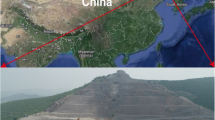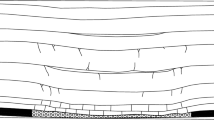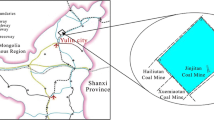Abstract
Tunnel Boring Machines (TBMs) have been used in many underground coal mines in China in recent years. The TBM is unfavorable to advance in complex geological conditions, especially in fractured zones. When the TBM advanced in the region, the surrounding rock mass damaged frequently and collapsed severely, which brought risks for the workers and reduced the advancing rate. Therefore, it is essential to precisely predict the location of fractured zones, and appropriate measures will be accordingly implemented to reduce the risks. In this research, the Measurement While Drilling (MWD) method based on rock drillability index was proposed to precisely detect the fractured zones. The Id was validated by laboratory and in situ tests. The results show that the Id is relative to rock strengths and sensitive to fractures. Base on the validation, we performed an MWD test in a deep coal mine roadway excavated via TBM to predict fractured zones affected by faults. The prediction shows a good consistency with actual geological conditions. It means that the MWD method based on rock drillability index can well detect the geological conditions during the TBM excavation.












Similar content being viewed by others
Data availability
The dates used to support the findings of this study are available from the corresponding authors upon request.
Abbreviations
- I d :
-
Rock drillability index
- D :
-
Diameter of the borehole
- F p :
-
Pushing force of drilling bit
- M :
-
Torque of drilling bit
- v :
-
Penetration velocity
- ω :
-
Angular velocity of drilling bit
- N :
-
Rotation speed of drilling bit
- A :
-
Area of hydraulic cylinder
- P 1 :
-
Pushing pressure of hydraulic cylinder
- P 2 :
-
Import pressure of the hydraulic motor
- P 0 :
-
Pressure of the hydraulic motor when the drilling bit is rotating, but not cutting rock
- MWD :
-
Measurement While Drilling
- UCS:
-
Uniaxial compressive strength
- MWDTS:
-
Measurement While Drilling test system
- PDC:
-
Polycrystalline diamond cutter
References
Bayati M, Khademi Hamidi J (2017) A case study on TBM tunnelling in fault zones and lessons learned from ground improvement. Tunn Undergr Space Technol 63:162–170. https://doi.org/10.1016/j.tust.2016.12.006
Capik M, Yilmaz AO, Yasar S (2016) Relationships between the drilling rate index and physicomechanical rock properties. Bull Eng Geol Env 76:253–261. https://doi.org/10.1007/s10064-016-0991-2
Farrokh E, Rostami J (2009) Effect of adverse geological condition on TBM operation in Ghomroud tunnel conveyance project. Tunn Undergr Space Technol 24:436–446. https://doi.org/10.1016/j.tust.2008.12.006
He M, Zhang Z, Li N (2021) Prediction of fracture frequency and RQD for the fractured rock mass using drilling logging data. Bull Eng Geol Env 80:4547–4557. https://doi.org/10.1007/s10064-021-02240-3
Hu XY, He C, Walton G et al (2020) A combined support system associated with the segmental lining in a jointed rock mass: the case of the inclined shaft tunnel at the Bulianta coal mine. Rock Mech Rock Eng 53:2653–2669. https://doi.org/10.1007/s00603-020-02056-9
Kahraman S (1999) Rotary and percussive drilling prediction using regression analysis. Int J Rock Mech Min Sci 36:981–989. https://doi.org/10.1016/S0148-9062(99)00050-9
Leung R, Scheding S (2015) Automated coal seam detection using a modulated specific energy measure in a monitor-while-drilling context. Int J Rock Mech Min Sci 75:196–209. https://doi.org/10.1016/j.ijrmms.2014.10.012
Lin CJ, Li SC (2014) Tunnel seismic prediction (TSP) and its application in tunnel engineering. Appl Mech Mater 501–504:1779–1782. https://doi.org/10.4028/www.scientific.net/AMM.501-504.1779
Liu QS, Huang X, Gong QM et al (2016) Application and development of hard rock TBM and its prospect in China. Tunn Undergr Space Technol 57:33–46. https://doi.org/10.1016/j.tust.2016.01.034
Markovaara Koivisto M, Hokkanen T, Huuskonen Snicker E (2014) The effect of fracture aperture and filling material on GPR signal. Bull Eng Geol Env 73:815–823. https://doi.org/10.1007/s10064-013-0566-4
Mellor M (1972) Normalization of specific energy values. International Journal of Rock Mechanics and Mining Sciences & Geomechanics Abstracts 9:661–663. https://doi.org/10.1016/0148-9062(72)90016-2
Niu GG, Zhang K, Yu BS et al (2019) Experimental study on comprehensive real-time methods to determine geological condition of rock mass along the boreholes while drilling in underground coal mines. Shock Vib 2019:1–17. https://doi.org/10.1155/2019/1045929
Paithankar AG, Misra GB (1976) A critical appraisal of the protodyakonov index. International Journal of Rock Mechanics and Mining Sciences & Geomechanics Abstracts 13:249–251. https://doi.org/10.1016/0148-9062(76)91545-X
Patel A (2013) Characterization of cavities in rocks using drilling parameters. Int J Rock Mech Min Sci 63:122–130. https://doi.org/10.1016/j.ijrmms.2013.08.014
Pessier RC, Fear MJ (1992) Quantifying common drilling problems with mechanical specific energy and a bit-specific coefficient of sliding friction. In: SPE Ann Tech Conf Exhibition. https://doi.org/10.2118/24584-ms
Petronio L, Poletto F (2002) Seismic-while-drilling by using tunnel boring machine noise. Geophysics 67:1798–1809. https://doi.org/10.1190/1.1527080
Petronio L, Poletto F, Schleifer A (2007) Interface prediction ahead of the excavation front by the tunnel-seismic-while-drilling (TSWD) method. Geophysics 72:G39–G44. https://doi.org/10.1190/1.2740712
Poletto F, Petronio L (2006) Seismic interferometry with a TBM source of transmitted and reflected waves. Geophysics. 71:SI85–SI93. https://doi.org/10.1190/1.2213947
Shi XM, Liu BG, Tannant D et al (2017) Influence of consolidation settlement on the stability of inclined TBM tunnels in a coal mine. Tunn Undergr Space Technol 69:64–71. https://doi.org/10.1016/j.tust.2017.06.013
Sun B, Yang S (2019) An improved 3D finite difference model for simulation of double shield TBM tunnelling in heavily jointed rock masses: the DXL tunnel case. Rock Mech Rock Eng 52:2481–2488. https://doi.org/10.1007/s00603-018-1730-8
Tang B, Cheng H, Tang YZ et al (2018) Experiences of gripper TBM application in shaft coal mine: a case study in Zhangji coal mine. China Tunnelling and Underground Space Technology 81:660–668. https://doi.org/10.1016/j.tust.2018.08.055
Teale R (1964) The concept of specific energy in rock drilling. International Journal of Rock Mechanics 2:57–73. https://doi.org/10.1016/0148-9062(65)90022-7
Van Eldert J, Funehag J, Saiang D et al (2020) Rock support prediction based on measurement while drilling technology. Bull Eng Geol Env 80:1449–1465. https://doi.org/10.1007/s10064-020-01957-x
Wang Q, Gao HK, Yu HC et al (2018) Method for measuring rock mass characteristics and evaluating the grouting-reinforced effect based on digital drilling. Rock Mech Rock Eng 52:841–851. https://doi.org/10.1007/s00603-018-1624-9
Xu XJ, Zhang PL, Guo X et al (2021) A case study of seismic forward prospecting based on the tunnel seismic while drilling and active seismic methods. Bull Eng Geol Env 80:3553–3567. https://doi.org/10.1007/s10064-020-02088-z
Xue X, Zhang K, Chen W et al (2022) A 3D Ubiquitous-Multiple-Joint model and its application to the stability analysis of TBM excavated roadway in jointed stratum. Rock Mech Rock Eng 56:1343–1366. https://doi.org/10.1007/s00603-022-03100-6
Yu BS, Zhang K, Niu GG (2021a) Rock strength determination based on rock drillability index and drilling specific energy: numerical simulation using discrete element method. IEEE Access 9:43923–43937. https://doi.org/10.1109/access.2021.3061552
Yu BS, Zhang K, Niu GG et al (2021b) Real-time rock strength determination based on rock drillability index and drilling specific energy: an experimental study. Bull Eng Geol Env 80:3589–3603. https://doi.org/10.1007/s10064-021-02154-0
Zhang K, Hou RB, Zhang GH et al (2015) Rock drillability assessment and lithology classification based on the operating parameters of a drifter: case study in a coal mine in China. Rock Mech Rock Eng 49:329–334. https://doi.org/10.1007/s00603-015-0723-0
Zheng YL, Zhang QB, Zhao J (2016) Challenges and opportunities of using tunnel boring machines in mining. Tunn Undergr Space Technol 57:287–299. https://doi.org/10.1016/j.tust.2016.01.023
Funding
This study was funded by the National Natural Science Foundation of China (grant number 52074260).
Author information
Authors and Affiliations
Contributions
Xinran Xue: methodology, conceptualization, validation, investigation, writing—original draft, writing—review and editing. Kai Zhang: methodology, conceptualization, writing—review and editing, supervision, funding acquisition. Fangyuan Xiao: methodology, investigation, writing—review and editing. Bailong Ma: writing—review and editing. Tao Jiang: writing—review and editing.
Corresponding author
Ethics declarations
Conflict of interest
The authors declare no competing interests.
Rights and permissions
Springer Nature or its licensor (e.g. a society or other partner) holds exclusive rights to this article under a publishing agreement with the author(s) or other rightsholder(s); author self-archiving of the accepted manuscript version of this article is solely governed by the terms of such publishing agreement and applicable law.
About this article
Cite this article
Xue, X., Zhang, K., Xiao, F. et al. Prediction of fractured zones in deep roadway of coal mine excavated via TBM based on Measurement While Drilling method. Bull Eng Geol Environ 82, 330 (2023). https://doi.org/10.1007/s10064-023-03360-8
Received:
Accepted:
Published:
DOI: https://doi.org/10.1007/s10064-023-03360-8




